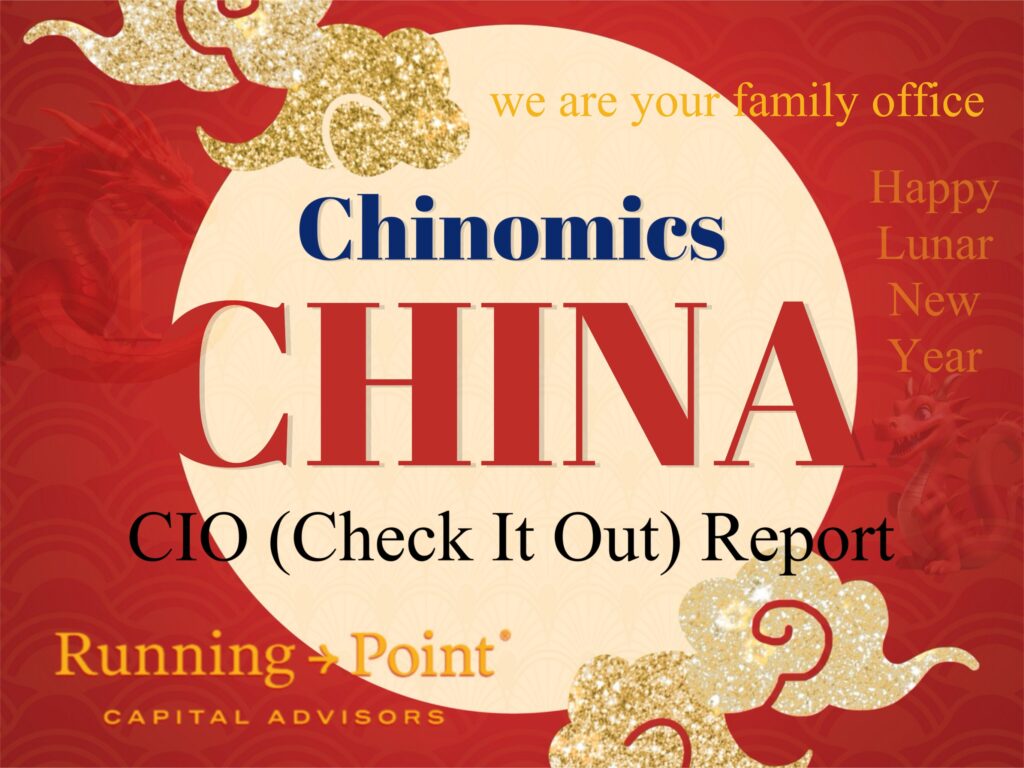Michael’s CIO (Check-It-Out) Report — events, sarcasm, and global macro reflections
February 11, 2024

THEME: CHINOMICS
Summary
China’s sluggish economic momentum has spurred policymakers to ramp up stimulus efforts. Beijing’s recent macro measures aim to bolster growth by supporting the real estate sector, adjusting foreign policy toward the U.S., and expanding the PBoC’s balance sheet alongside targeted rate cuts. However, these steps alone may not be sufficient to sustainably boost domestic demand. Beijing must demonstrate a stronger commitment to growth, address policy volatility, and provide more substantial fiscal support. The housing sector remains pivotal for China’s economic prospects, although deflationary pressures persist. While Chinese equities may appear undervalued and have seen government intervention, a structural improvement in the outlook requires more significant measures which we may see after the Lunar New Year🐲
CHIMONICS Detail
This week, China appointed Wu Qing as chairman of the China Securities Regulatory Commission (CSRC), replacing Yi Huiman.
Changes
Not surprising that China is taking drastic measures to boost investor confidence, in fact it has been widely hinted and broadcast that they will do so. Thus, the replacement of its head securities regulator amidst a long slide in the nation’s stock markets should not be a huge shock, especially since this is a proactive administration that historically is willing to replace people that don’t live up to expectations.
More to come
Wu Qing, former chairman of the Shanghai Stock Exchange, a banking veteran, and also known as the “the broker butcher”, is much less subdued and understated than Yi Huiman. In 2022 Qing emerged as an alternate member of the Communist Party’s Central (CPC) Committee, hinting at his rise in stature, and his appointment sends a serious signal that Beijing is willing to install someone that can shake things up and right the ship. But China will have to do a lot more than just install a new regulator (chairman of the China Securities Regulatory Commission) to prop their stock and financial markets because on his own, he does not have the power to improve economic growth nor resolve the country’s real estate quagmire.
Timing—Year of the Dragon🐉
That they are making this move ahead of the Lunar New Year holiday, when many businesses shut down, is probably a signal that more initiatives will follow. I expect China to follow this change at the top with more market and economic support measures, possibly after the Lunar New Year public holiday ends on February 17 or after the Lantern Festival on February 24.
Exchanges📊
Fundamentally, stock market exchanges are supposed to nurture and support businesses by helping their capital formation endeavors; many of today’s small and medium sized businesses will be tomorrow’s market leaders. Thus, the establishment and support of well-functioning markets promotes development that is fundamental to the healthy advancement of the economy.
Intervention🧤
Heavy-handed market intervention will not be appreciated; if the new leadership prioritizes curbing stock price fluctuations through strict transaction limitations, it could backfire, further eroding investor confidence. Nonetheless, China did suspend new lending for stock selling. On the other hand, encouraging state-owned entities to strategically buy up stocks, monetary easing from the PBOC, a cleansing of bad real estate debt, and other stimulative growth measures could help restore investor confidence; and confidence is almost always the cheapest and best stimulus. For example, China’s sovereign wealth fund announced increase in ETF purchases as a way to prop the stock market.
Wait-and-see⏳
While aggressive investors may step into the market now expecting more support from Beijing, many remain skeptical after last year’s drastic market disappointment. They’re adopting a “wait-and-see” approach, demanding concrete, impactful measures before committing their Yuans. The question for Beijing is: will their actions ignite confidence or further fuel investor doubt?
China’s path
Chinese President Xi Jinping emphasized commitment to China’s distinct financial development path during an annual study session, highlighting its divergence from the West. As expected, Xi outlined his vision of a financial superpower based on a robust economic foundation, world-leading economic, technological, and national strength.
Investors need to discern the effects and influences of China vs. China, China vs. the U.S., and China vs. India.
Deflation, decoupling, and debt
China’s GDP deflator fell by 1.5% in Q4 2023, the longest decline since 1999, indicating a potential recession. Despite Premier Li Qiang’s optimistic 5.2% economic growth announcement at Davos, deflation is evident in recent Q4 data. China faces global challenges including decoupling from the West, foreign capital withdrawal, US tech restrictions, and new snags in China’s massively expensive 11-year old Belt and Road Initiative (BRI) as Italy pulled out and security concerns in Pakistan make headlines. Strong growth, even if achieved, is unlikely to alleviate China’s mounting bad debt. Beijing’s struggle for structural changes leans towards credit-fueled stimulus, raising concerns about achieving desired outcomes.
Key concerns
The crisis-mired property sector remains a key concern, with weak sales, default risks, and a consensus among major financial institutions projecting a continued slump in 2024. Despite government efforts, the pessimistic outlook signals ongoing economic challenges. All this begs the question of whether their “Made in China 2025” economic development strategy is at risk. Additionally, demographic concerns, with deaths outnumbering births by the largest margin in history, pose long-term expansion challenges on par with Europe.
Rescue package?⛑
Amid rumors of a $278 billion stock market rescue package, state-owned banks in China are expected to buy onshore stocks to counter a $6 trillion market rout since 2021. Beijing’s surprising measures to boost the stock market include potential state-owned enterprise fund use, executive evaluation based on stock market value, and efforts to open the financial industry to international investors. The central bank’s unexpected move to slash cash reserves resulted in a market upturn that could have legs; thus, over the short to medium term we may see stocks move up even if long-term economic ills are not immediately cured.
Crisis of confidence📉
While the recent measures provided short-term relief, investors remain cautious about long-term economic prospects. Six months of consecutive outflows, totaling $30 billion in foreign institutional sales of mainland Chinese shares, indicate persistent concerns.
Sinking property values impact confidence, limiting available capital for investments. Beijing’s historical market interventions have shown short-lived impacts, raising uncertainty about the package’s real value.
Growth as a cure📈
However, growth can cure most ailments, including a ginormous debt load. If China can stimulate real domestic growth, lean on global economic expansion, and increase confidence, they should have a path that’s up and to the right. PBOC Governor Pan Gongsheng was clear about the central bank’s direction, emphasizing that the PBOC is deeply concerned about deflation and sees a pressing need to ease monetary policy and steer credit where needed. Ironically, any easing of interest rates from the U.S. Federal Reserve could also help China by stimulating global growth/demand. All economies go through their cyclical ups and downs; if properly wielded, China has the tools to turn things around and surprise the world yet again.
The India question
While most people in the U.S. are focused on America versus China, the real challenge may be an Indo-Pacific one as the battle shifts towards India versus China on the global stage for products, services, and diversification of supply chains. India has a much younger population and is growing so quickly it will surpass Japan as the third-largest economy before the end of the decade. The comparison between China and India is not one of simple contrasts and similarities; there are multiple layers of complex history and politics too.
Demographics or Declineographics
China’s population is projected to decline from 1.4 billion people today to 800MM by the end of the century. The country enacted a one-child policy in 1980 that helped to significantly decrease the birthrate. Even though it ended the policy in 2016 and started its three-child policy in 2021 (encouraging couples to have three children), birthrates have not increased. A generation of children raised solo are not eager to start large families. Currently, 18% of China’s population is older than 60, but by 2040 that share could rise to 32%. The headwinds from China’s aging and declining population have significant implications for growth, savings, and foreign exchange reserve accumulation and, therefore, Chinese appetite for owning US Treasuries which has been declining for several years.
Trumponomics
Trump claims he will consider a greater than 60% tariff on Chinese goods if elected—of course, consider is different than implement
Decoupling
Even though the U.S. continues to have the worst goods trade deficit with China (including Hong Kong), the U.S. trade deficit with China fell last year to its lowest level since 2010.
- The deficit with China decreased $103 billion to $279B in 2023: exports decreased $6 billion to $148B and imports decreased $109B to $427B.
Mexico has now surpassed China to become the largest exporter of goods to the U.S. However, this does not tell the whole story since manufacturers have found numerous ways around tariffs and quotas by assembling Chinese parts in other countries.
PERSONAL
PPLI/PPVA: In January I spoke at “Deep Dive Into PPLI & PPVA” this week in Winter Gardens, Florida in conjunction with the 58TH Annual Heckerling Institute on Estate Planning. We discussed private placement life insurance (PPLI) and private placement variable annuities (PPVA) for wealth generation, wealth transfer, tax & estate planning, and life insurance efficiency with institutional pricing
Private Credit: A week ago I spoke on a private credit panel at the Nuveen Investment Summit in Los Angeles
Secondaries: Find me this week at Carmo’s Private Markets Secondaries Meeting in Santa Monica
Family Office: I’ll speak on March 5 at the Family Office “Beverly Hills Super Summit”, regarding Private Investor Mandates: Preferences and Strategies of Ultra-Wealthy Private Investors at the Sofitel
Real estate: In March, I’ll moderte a real estate panel at the ALTSLA alternative investment conference in downtown Los Angeles—organized by CFA, CAIA, CalAlts, and Markets Group
Venture Capital: On April 8, find me at SuperVenture US West in Los Angeles, on a portfolio construction panel
Private investents: On April 9, hear me at SuperReturn US West in L.A., where I’ll speak about “Democratisation: What managers need to know to attract new sources of capital”
Best wishes for the week (and year) ahead😃,
Michael
~~~
Michael Ashley Schulman, CFA
Partner & Chief Investment Officer
Running Point Capital Advisors, your family office
“We deliver custom investment solutions, family office services, innovations, and unique perspectives to you and your family—we are your family office—you can emphasize your enjoyments, priorities, and legacy.”
Disclosure: The opinions expressed are those of Running Point Capital Advisors, LLC (Running Point) and are subject to change without notice. The opinions referenced are as of the date of publication, may be modified due to changes in the market or economic conditions, and may not necessarily come to pass. Forward-looking statements cannot be guaranteed. Running Point is an investment adviser registered with the U.S. Securities and Exchange Commission. Registration does not imply a certain level of skill or training. More information about Running Point’s investment advisory services and fees can be found in its Form ADV Part 2, which is available upon request. RP-24-20


